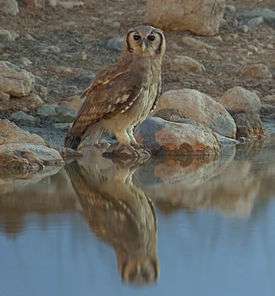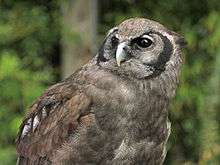Verreaux's eagle-owl
| Verreaux's eagle-owl | |
|---|---|
 | |
| From Etosha National Park | |
| Scientific classification | |
| Kingdom: | Animalia |
| Phylum: | Chordata |
| Class: | Aves |
| Order: | Strigiformes |
| Family: | Strigidae |
| Genus: | Bubo |
| Species: | B. lacteus |
| Binomial name | |
| Bubo lacteus Temminck, 1820 | |
Verreaux's eagle-owl, also known as the milky eagle owl or giant eagle owl,[2] (Bubo lacteus) is a member of the family Strigidae and is the largest African owl. This owl is the world's fourth heaviest living owl, after Blakiston's fish owl, the Eurasian eagle-owl and the tawny fish owl, and is also the fourth longest living owl, after the great gray, Blakiston's fish and Eurasian eagle-owls.[3]
The common name commemorates the French naturalist Jules Verreaux.[4]
Description
Verreaux's eagle-owl is a very large and powerful owl species. It ranges from 60–66 cm (24–26 in) in length.[2][5] This species has an average wingspan of 140 cm (55 in).[2] The body mass is 1,600–2,000 g (3.5–4.4 lb) in males, with an average of 1,700 g (3.7 lb) against a body mass of 2,500–3,150 g (5.51–6.94 lb), averaging 2,625 g (5.787 lb), in the larger females.[2] Among standard measurements, each wing chord measures 42–49 cm (17–19 in), the tail is 22–27.5 cm (8.7–10.8 in) long and the tarsus is 8 cm (3.1 in).
In appearance, they are distinguished by a whitish oval disk face with a black border and their pink eyelids.[6] Their eyes are orange in color and they have two fluffy ear-tufts. Overall, they are a fairly uniform brownish-gray, with light vermiculations above and white spots on the shoulder. They are paler on the underside.
The male's song is a deep gwok, gwok, gwonk-gwokwokwok gwokwokwok gwonk. The female's call is similar but higher pitched. The alarm calls of both sexes are often a sonorous whok but variable grunting notes and raspy screams also seem to indicate alarm. Both the female and the young engage in high, piercing calls when begging for food at the nest (at which time the male does the food capture).
Range and Habitat
Verreaux's eagle-owl is found through most of Sub-Saharan Africa, though it is absent from most of the deep rainforests. They are also found in the Middle East. The species is found at the highest densities in eastern and southern Africa. They inhabit mainly semi-desert or dry savanna with scattered trees and thorny vegetation. They also range into riverine forest adjacent to savanna and small, semi-open woodland surrounded by open country, though they are less likely in more wooded habitats. They may inhabit all elevations, from sea-level to snow line.
Behavior
They are nocturnal birds and roost in trees, with large, shaded horizontal branches of tall, old trees preferred. They sleep lightly and will awaken very quickly to defend themselves from attack in daylight hours. Breeding pairs and their offspring frequently roost together and may engage in allopreening during this time.
Food
Verreaux's eagle-owl is considered an avian apex predator, meaning it is at or near the top of the food chain and healthy adults normally have no natural predators. They hunt predominantly in early evening though have been observed to swoop on prey during daylight. The owls usually fly to a different perch from their daytime roost to do their hunting. Verreaux's eagle-owls mainly hunt by gliding down on their prey from a perch.
Full-grown owls feed on a variety of prey items, with medium-sized mammals and large birds being preferred. Commonly recorded mammalian prey has included young and adult monkeys, springhares, hares, genets, hyraxes, mongoose, ground squirrels, bats and various rats and mice. They are one of the very few birds to favor hedgehogs as prey. When hedgehogs are caught, as in the Eurasian eagle-owl, the spiky skin on their backs are peeled and discarded.[7] Avian prey can range in size from penduline tits, weavers and waxbills to large herons and bustards and can include francolins, guineafowl, ducks, vultures, nestling and occasionally adult bateleurs, secretarybirds, hornbills, ostriches, and cranes.[8] Other prey can vary considerably, including reptiles, toads, fish and arthropods including insects, millipedes, scorpions and spiders. They have been observed actively hawking for insects in flight. They have been recorded to fly with mongoose weighing over 1.8 kg (4.0 lb) and have killed and flown with even larger half-grown vervet monkeys. Very large prey items, such as warthog piglets and Denham's bustards, may be too heavy if they are heavier than the preying owl and, in such cases, will be left at the kill site for both owls in a pair to return to and feed on repeatedly.[8] On occasion, they hunt by flying low over a bush to catch prey by surprise or dash into dense foliage or through forests to catch a galago or other arboreal prey item. They will also sometimes run after prey on the ground or wade into shallow waters to pin down fish. Near cities, their prey can include common urban creatures such as rats and pigeons. Although they overlap in range with several raptors, including larger eagles such as crowned, martial, golden, and Verreaux's eagle, they rarely interact and are likely to rarely compete given their differing periods of activity. However, any other hawk or owl encountered, including the very large Pel's fishing owl, are potential prey for the Verreaux's eagle-owl.[8] Despite its place near the top of the nocturnal avian food chain, in 2013 a remote wildlife camera videotaped a jackal attacking and killing a Verreaux's eagle owl at a watering hole.[9]
Breeding
Breeding takes place from March to September.[10] The monogamous pair defends their territory by their song and sometimes (though rarely) through duets. Usually breeding occurs every year but, when food densities are low, may occur only ever 2 or 3 years. They may use a variety of sites for nesting, including old weaver, hamerkop, secretarybird or other raptor nests the size of huge platiform nests constructed by Old World vultures. It may occasionally nest also in tree cavities or on very dense tangles of creepers or orchids.[8] The female lays two white eggs, which typically measure 62.6 mm × 51.4 mm (2.46 in × 2.02 in) and weigh 93–101.6 g (3.28–3.58 oz) and are laid at up to 7 day intervals. She incubates the eggs for 33 to 39 days. She remains on the nest for the entire incubation period while the male hunts for food for both of them.
Upon hatching, the new young weigh 60–70 g (2.1–2.5 oz) and almost right away have apparent pink eyelids. The first egg to hatch is the first to be fed, and if food is not plentiful only, the second chick often starves to death. If food is abundant, both owlets will be fed and may survive. The female broods the chicks consistently for 20 days. Intruding animals who get too close to the nest are attacked. The chicks are ready to leave the nest at around 63 days of age but only fly well around 2 weeks after this. The fledgings are hidden and rather inactive for around 3 months, only starting to catch their own prey at around 5 months. Some young may remain with their parents for up to 2 years. Sexual maturity is reached at 3 to 4 years of age. There is little data on longevity in wild adults, although captive ones have lived for up to 15 years.
Status
Verreaux's eagle-owl is a seldom-encountered species, occurring at low densities and needing large territories for hunting and breeding purposes. They are sometimes locally rare due to persecution (they are possible predators of small domestic stock, though this must be rare) and the residual effects of pesticides (poison consumed through prey may badly effect them). However, they are widespread and are not currently considered to be threatened at the species level.
References
- ↑ BirdLife International (2012). "Bubo lacteus". IUCN Red List of Threatened Species. Version 2013.2. International Union for Conservation of Nature. Retrieved 26 November 2013.
- 1 2 3 4 Giant Eagle-Owl, Arkive
- ↑ CRC Handbook of Avian Body Masses, 2nd Edition by John B. Dunning Jr. (Editor). CRC Press (2008), ISBN 978-1-4200-6444-5.
- ↑ Beolens, Bo; Watkins, Michael (2003). Whose Bird? Men and Women Commemorated in the Common Names of Birds. London: Christopher Helm. pp. 350–351.
- ↑ Field Guide to the Birds of East Africa: Kenya, Tanzania, Uganda, Rwanda, Burundi by Stevenson & Fanshawe. Elsevier Science (2001), ISBN 978-0856610790
- ↑ Animal Photo Album. Animal Pictures Archive. Retrieved on 2012-08-24.
- ↑ Dave Taylor's African Safari: Trophic Level IV: Large Carnivores – Verreaux's Eagle Owl – Page 2. sensesofwildness.com
- 1 2 3 4 Bubo lacteus (Verreaux's eagle-owl, Giant eagle owl). Biodiversityexplorer.org. Retrieved on 2012-08-24.
- ↑ "GRAPHIC: Jackal Kills Giant Eagle Owl at Pete's Pond 7-11-2013". YouTube. Retrieved 2014-12-02.
- ↑ Verreaux's Eagle-Owl. Owls.org (2012-08-19). Retrieved on 2012-08-24.
- Owls of the World by Konig, Weick & Becking. Yale University Press (2009), ISBN 0300142277
External links
| Wikimedia Commons has media related to Bubo lacteus. |
| Wikispecies has information related to: Bubo lacteus |
- (Giant Eagle-Owl =) Verreaux's Eagle-Owl – Species text in The Atlas of Southern African Birds.
- Verreaux's Eagle-Owl videos, photos & sounds on the Internet Bird Collection

